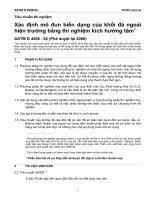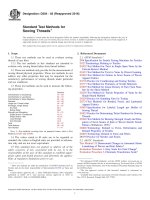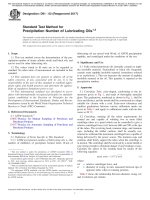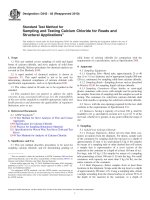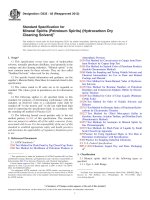Astm d 91 02 (2017)
Bạn đang xem bản rút gọn của tài liệu. Xem và tải ngay bản đầy đủ của tài liệu tại đây (85.22 KB, 3 trang )
This international standard was developed in accordance with internationally recognized principles on standardization established in the Decision on Principles for the
Development of International Standards, Guides and Recommendations issued by the World Trade Organization Technical Barriers to Trade (TBT) Committee.
Designation: D91 − 02 (Reapproved 2017)
Standard Test Method for
Precipitation Number of Lubricating Oils1,2
This standard is issued under the fixed designation D91; the number immediately following the designation indicates the year of original
adoption or, in the case of revision, the year of last revision. A number in parentheses indicates the year of last reapproval. A superscript
epsilon (´) indicates an editorial change since the last revision or reapproval.
This standard has been approved for use by agencies of the U.S. Department of Defense.
lubricating oil are mixed with 90 mL of ASTM precipitation
naphtha, and centrifuged under the conditions of the test.
1. Scope
1.1 This test method covers the determination of the precipitation number of steam cylinder stocks and black oils, and
can be used for other lubricating oils.
4. Significance and Use
4.1 Fully refined petroleum oils normally contain no naphtha insoluble material. Semirefined or black oils frequently
contain some naphtha insoluble material (sometimes referred
to as asphaltenes ). This test measures the amount of naphtha
insoluble material in the oil. This quantity is reported as the
precipitation number.
1.2 The values stated in SI units are to be regarded as
standard. No other units of measurement are included in this
standard.
1.3 This standard does not purport to address all of the
safety concerns, if any, associated with its use. It is the
responsibility of the user of this standard to establish appropriate safety and health practices and determine the applicability of regulatory limitations prior to use.
1.4 This international standard was developed in accordance with internationally recognized principles on standardization established in the Decision on Principles for the
Development of International Standards, Guides and Recommendations issued by the World Trade Organization Technical
Barriers to Trade (TBT) Committee.
5. Apparatus
5.1 Centrifuge Tube, cone-shaped, conforming to the dimensions given in Fig. 1, and made of thoroughly annealed
glass. The graduations, numbered as shown in Fig. 1, shall be
clear and distinct, and the mouth shall be constructed in a shape
suitable for closure with a cork. Scale-error tolerances and
smallest graduations between various calibration marks are
given in Table 1 and apply to calibrations made with air-free
water at 20 °C.
2. Referenced Documents
2.1 ASTM Standards:3
D4057 Practice for Manual Sampling of Petroleum and
Petroleum Products
D4177 Practice for Automatic Sampling of Petroleum and
Petroleum Products
5.2 Centrifuge, meeting all the safety requirements for
normal use and capable of whirling two or more filled
centrifuge tubes at a speed which can be controlled to give a
relative centrifugal force (rcf) between 600 and 700 at the tips
of the tubes. The revolving head, trunnion rings, and trunnion
cups, including the rubber cushion, shall be soundly constructed to withstand the maximum centrifugal force capable of
being delivered by the power source. The trunnion cups and
cushions shall firmly support the tubes when the centrifuge is
in motion. The centrifuge shall be enclosed by a metal shield or
case strong enough to eliminate danger if any breakage occurs.
Calculate the speed of the rotating head by means of the
following equation:
3. Terminology
3.1 Definitions of Terms Specific to This Standard:
3.1.1 ASTM precipitation number, of lubricating oils, n—the
number of millilitres of precipitate formed when 10 mL of
1
This test method is under the jurisdiction of ASTM Committee D02 on
Petroleum Products, Liquid Fuels, and Lubricants and is the direct responsibility of
Subcommittee D02.06 on Analysis of Liquid Fuels and Lubricants.
Current edition approved July 1, 2017. Published July 2017. Originally approved
in 1921. Last previous edition approved in 2012 as D91 – 02 (2012)ɛ1. DOI:
10.1520/D0091-02R17.
2
This test method has been adopted for use by government agencies to replace
Method 3101 of Federal Test Method Standard No. 791b.
3
For referenced ASTM standards, visit the ASTM website, www.astm.org, or
contact ASTM Customer Service at For Annual Book of ASTM
Standards volume information, refer to the standard’s Document Summary page on
the ASTM website.
speed, r/min 5 1337 =rcf/d
(1)
where:
rcf = relative centrifugal force, and
d
= diameter of swing, in mm, measured between tips of
opposite tubes when in rotating position.
Table 2 shows the relationship between diameter swing, rcf,
and revolutions per minute.
Copyright © ASTM International, 100 Barr Harbor Drive, PO Box C700, West Conshohocken, PA 19428-2959. United States
1
D91 − 02 (2017)
to the 100 mL mark with hexanes and close tightly with a
softened cork (not a rubber stopper). Then invert each tube at
least 20 times, allowing the liquid to drain thoroughly from the
tapered tip of the tube each time. Place the tubes in a water bath
at 32 °C to 35 °C for 5 min 6 1 min. Momentarily remove the
corks to relieve any pressure, and invert each tube again at least
20 times exactly as before. The success of this method depends
to a large degree upon having a thoroughly homogeneous
mixture which will drain quickly and completely from the
tapered tip when the tube is inverted.
8.2 Balance the two centrifuge tubes or pairs of tubes with
their respective trunnion cups and place them on opposite sides
of the centrifuge head. Then whirl them for 10 min at a rate
sufficient to produce a relative centrifugal force (rcf) between
600 and 700 at the tips of the whirling tubes (see 5.2). Repeat
this operation until the volume of sediment in each tube
remains constant for three consecutive readings. In general, not
more than four whirlings will be required for oils having a low
precipitation number.
NOTE 1—For volumetric tolerances see Table 1.
9. Calculation and Report
FIG. 1 ASTM Cone-Shaped Centrifuge Tube
9.1 Read the volume of the solid sediment at the bottom of
each centrifuge tube, estimating to 0.1 mL or closer if possible.
If the two readings differ by not more than 0.1 mL, report the
mean of the two as the ASTM Precipitation Number. If the two
readings differ by more than 0.1 mL, make two more determinations and report the average of the four determinations.
TABLE 1 Calibration Tolerances for 200 mm Centrifuge Tube
Range, mL
0 to 0.1
Above 0.1 to 0.3
Above 0.3 to 0.5
Above 0.5 to 1.0
Above 1.0 to 2.0
Above 2.0 to 3.0
Above 3.0 to 5.0
Above 5.0 to 10
Above 10 to 25
Above 25 to 100
Subdivision, mL
Volume Tolerance, mL
0.05
0.05
0.05
0.10
0.10
0.20
0.5
1.0
5.0
25
±0.02
±0.03
±0.05
±0.05
±0.10
±0.10
±0.20
±0.50
±1.00
±1.00
10. Precision and Bias
10.1 The precision of this test method as determined by
statistical examination of interlaboratory results is as follows:
10.2 Repeatability—The difference between two test results,
obtained by the same operator with the same apparatus under
constant operating conditions on identical test material, would
in the long run, in the normal and correct operation of the test
method, exceed the following values only in one case in
twenty:
TABLE 2 Rotation Speeds for Centrifuges of Various Diameters
A
Diameter of Swing, mmA
r/min at 600 rcf
r/min at 700 rcf
483
508
533
559
1490
1450
1420
1390
1610
1570
1530
1500
Precipitation Number
0.00 to 1.20
Repeatability
10 % of Mean
10.3 Reproducibility—The difference between two single
and independent results obtained by different operators working in different laboratories on identical test material would, in
the long run, in the normal and correct operation of the test
method, exceed the following values only in one case in
twenty:
Measured in millimetres between tips of opposite tubes when in rotating position.
6. Reagent
6.1 Hexanes, Reagent Grade. (Warning—Extremely
flammable, harmful if inhaled.)
Precipitation Number
0.00 to 1.20
7. Sampling
Reproducibility
30 % of Mean
10.4 Bias—This procedure is empirical, precipitation number is defined solely by this procedure, therefore, no statement
of bias can be made.
7.1 For sampling techniques, see Practices D4057 or Practice D4177.
8. Procedure
11. Keywords
8.1 Add 10 mL 6 1 mL of the oil to be tested in each of two
clean, dry centrifuge tubes at room temperature. Fill each tube
11.1 asphaltenes; lubricating oils; precipitation number
2
D91 − 02 (2017)
ASTM International takes no position respecting the validity of any patent rights asserted in connection with any item mentioned
in this standard. Users of this standard are expressly advised that determination of the validity of any such patent rights, and the risk
of infringement of such rights, are entirely their own responsibility.
This standard is subject to revision at any time by the responsible technical committee and must be reviewed every five years and
if not revised, either reapproved or withdrawn. Your comments are invited either for revision of this standard or for additional standards
and should be addressed to ASTM International Headquarters. Your comments will receive careful consideration at a meeting of the
responsible technical committee, which you may attend. If you feel that your comments have not received a fair hearing you should
make your views known to the ASTM Committee on Standards, at the address shown below.
This standard is copyrighted by ASTM International, 100 Barr Harbor Drive, PO Box C700, West Conshohocken, PA 19428-2959,
United States. Individual reprints (single or multiple copies) of this standard may be obtained by contacting ASTM at the above
address or at 610-832-9585 (phone), 610-832-9555 (fax), or (e-mail); or through the ASTM website
(www.astm.org). Permission rights to photocopy the standard may also be secured from the Copyright Clearance Center, 222
Rosewood Drive, Danvers, MA 01923, Tel: (978) 646-2600; />
3
